Monday 15th April, 2024
Tuesday 16th April, 2024
Wednesday 17th April, 2024
Thursday 18th April, 2024
Friday 19th April, 2024
COMET researcher Tamarah King, based at the University of Oxford, has recently written a blog providing a research update on the COMET Central Asia Fault Database; progress report.
The COMET Central Asia Fault Database integrates decades of fault mapping and field-studies by researchers from the UK NERC Centre for Observation and Modelling of Earthquakes, Volcanoes and Tectonics (COMET), and global collaborators.
Central Asia is home to one of the world’s great mountain ranges–the Tien Shan–which is formed by vigorous crustal convergence across a multitude of tectonic faults. Here we describe the motivation to assemble the database and the choices that we have made in its structure, which are based on utility, necessity, and limitations in available information. We are working towards a full public release of the dataset, so keep an eye out!
Key points:
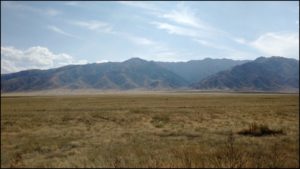
Background Motivation
COMET researchers have been investigating active tectonic structures across the Central Asia region since the early 2000s through programs such as Earthquakes without Frontiers and Looking Inside the Continents from Space, along with local partner institutions in the region such as the Kyrgyz Institute of Seismology. Alongside remote mapping, field campaigns with collaborators have produced a large amount of tectonic and earthquake related information. The COMET Central Asia Fault Database assembles these data to produce a cohesive fault database of use to a wide range of geoscientists, as has been done recently across other regions of the planet.
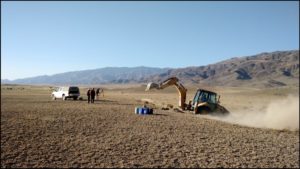
Individual contributors had mapped faults at variable times (~2000 to present), variable resolutions (field-mapping to coarse satellite imagery), and for variable purposes (field site to continental-tectonic scale studies). Rather than reduce this variability to a single representation of the fault network, we produce a database that contains three resolution levels, to increase suitability for various applications.
The blog continues at Blog – Earthquakes in Central Asia.
In the meantime, if you’d like to be involved or would like more information, please get in touch with Tamarah King via tamarah.king@earth.ox.ac.uk
COMET scientists Professor Juliet Biggs (University of Bristol) and Professor Andy Hooper (University of Leeds) both serve on the Harmony Mission Advisory Group and are delighted to have been chosen to develop the concept further.
On February 18-19, ESA’s Programme Board for Earth Observation (PB-EO) decided on the continuation of the three Earth Explorer (EE) mission candidates towards the next phase in the path to their implementation. The three missions, namely, Daedalus, Hydroterra and Harmony, were selected in 2018 for a Phase-0 feasibility study out of 21 submitted proposals. The PB-EO has made now the unprecedented decision of selecting only one mission for Phase A, namely Harmony, instead of more than one as done in previous EE calls.
The Harmony mission is dedicated to the observation and quantification of small-scale motion and deformation fields at the air-sea interface (winds, waves, surface currents), of solid Earth (tectonic strain and height changes at volcanoes), and in the cryosphere (glacier flows and height changes). In order to achieve the different mission goals, the Harmony mission shall deploy two companion satellites following one of ESA’s Copernicus Sentinel-1 satellites. The companions will be flying in two different formations (see Figure 1): the stereo formation, with one Harmony satellite placed in front and one behind Sentinel-1, in both cases at a distance of about 350 km from it; and the cross-track formation, with both Harmony units flying close to each other (~200-500 m) also at 350 km from Sentinel-1. Each Harmony satellite carries as main payload a receive-only synthetic aperture radar (SAR), which shall acquire the reflected signals transmitted by Sentinel-1 towards the Earth. A multi-view thermal infra-red payload is also included to measure cloud height and cloud motion vectors. The angular diversity provided by the Harmonies in combination with Sentinel-1 will allow the retrieval of deformation measurements of the sea and earth surface with unprecedented accuracy (see Figure 2), while the cross-track configuration will allow the accurate measurement of elevation changes for land-ice and volcanic applications.
Figure 1: Representation of the (left) stereo and (right) cross-track flying formations for Harmony. The Sentinel-1 satellite is depicted in black color. Sentinel-1 transmits a signal and acquires the backscattered echoes (represented with magenta arrows), while the Harmony satellites receive part of the energy that bounces towards them (represented with the green arrows). Copyright: Harmony Mission Advisory Group.
Dr. Paco López-Dekker from the Delft University of Technology and principal investigator of the Harmony mission, comments “It is very exciting that our multi static-SAR concept, which combines many ideas that were matured during my years at HR, has made it to this final stage. During Phase-0 we have drafted a beautiful and elegant mission concept promising an unprecedented view at Earth System processes. Now we have the responsibility to look at it from all sides and be sure that it will work. Challenging and fun.”
Professor Juliet Biggs from the University of Bristol and member of Harmony’s Mission Advisory Group at ESA adds “The Harmony mission is remarkable in that it promises new scientific discoveries across an astonishing breadth of topics: from the gradual motion of tectonic plates to small-scale processes on the ocean surface. I’m delighted that we have been selected to develop the concept further and that Harmony is one step closer to becoming a reality”
Dr. Pau Prats, from the German Aerospace Centre, DLR and member of Harmony’s Mission Advisory Group at ESA, is convinced of the benefits a mission like Harmony will bring to the community: “The unique configuration of the Harmony satellites in combination with Sentinel-1 will allow us to literally add a new dimension to SAR observations, a fact that will foster SAR technology and its applications during the next two decades.”
Figure 2: Coloured areas show regions straining at greater than 10 nanostrain per year (the threshold above which 95% of earthquake fatalities occur). Blue regions are those that have a small component of north-south strain and can be imaged by Sentinel-1 alone. Red regions indicate the extra area that will be constrained by Harmony. From Harmony Report for Assessment. 2020.
So, what’s next? Even though Harmony is currently the only EE-10 mission candidate it does not mean it will be implemented. The industry and science teams have one and a half years of hard work ahead to demonstrate the mission has reached the technological and scientific level of maturity required to enter into the next phase, that will ultimately result in the launch of the Harmony satellites by the end of this decade.
Announcement can be found on ESA website: https://www.esa.int/Applications/Observing_the_Earth/ESA_moves_forward_with_Harmony
Title figure for the Harmony mission. Copyright: ESA.
The timing and size of three deadly earthquakes that struck Italy in 2016 may have been pre-determined, according to new research published in Earth and Planetary Science Letters that could improve future earthquake forecasts.
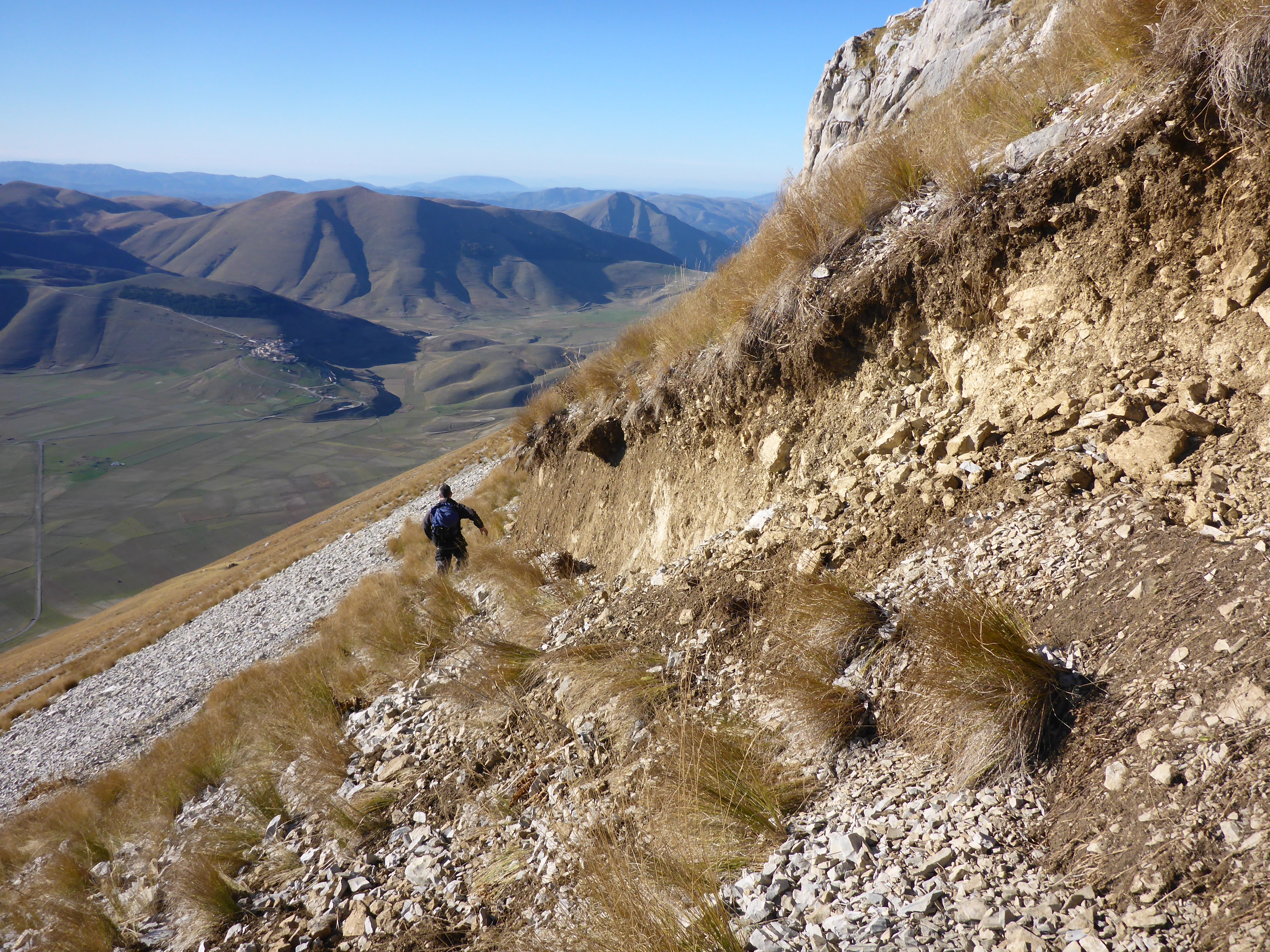
A joint British-Italian team of geologists and seismologists have shown that the clustering of the three quakes might have been caused by the arrangement of a cross-cutting network of underground faults.
The findings show that although all three earthquakes occurred on the same major fault, several smaller faults prevented a single massive earthquake from occurring instead and also acted as pathways for naturally occurring fluids that triggered later earthquakes.
The cluster of three earthquakes, termed a “seismic sequence” by seismologists, each had magnitudes greater than six and killed more than 300 people in Italy’s Apennine mountains between 24 August and 30 October 2016.
Earthquake sequences
The research, led by COMET scientist Richard Walters from Durham University, comes on the second anniversary of the start of the earthquake sequence.
The researchers say the findings could have wider implications for the study of seismic hazards, enabling scientists to better understand potential earthquake sequences following a quake.
Dr Walters said: “These results address a long-standing mystery in earthquake science – why a major fault system sometimes fails in a single large earthquake that ruptures its entire length, versus failing in multiple smaller earthquakes drawn-out over months or years.
“Our results imply that even though we couldn’t have predicted when the earthquake sequence would start, once it got going, both the size and timing of the major earthquakes may have been pre-determined by the arrangement of faults at depth.
“This is all information we could hypothetically know before the event, and therefore, this could be a hugely important avenue for improving future earthquake forecasts.”
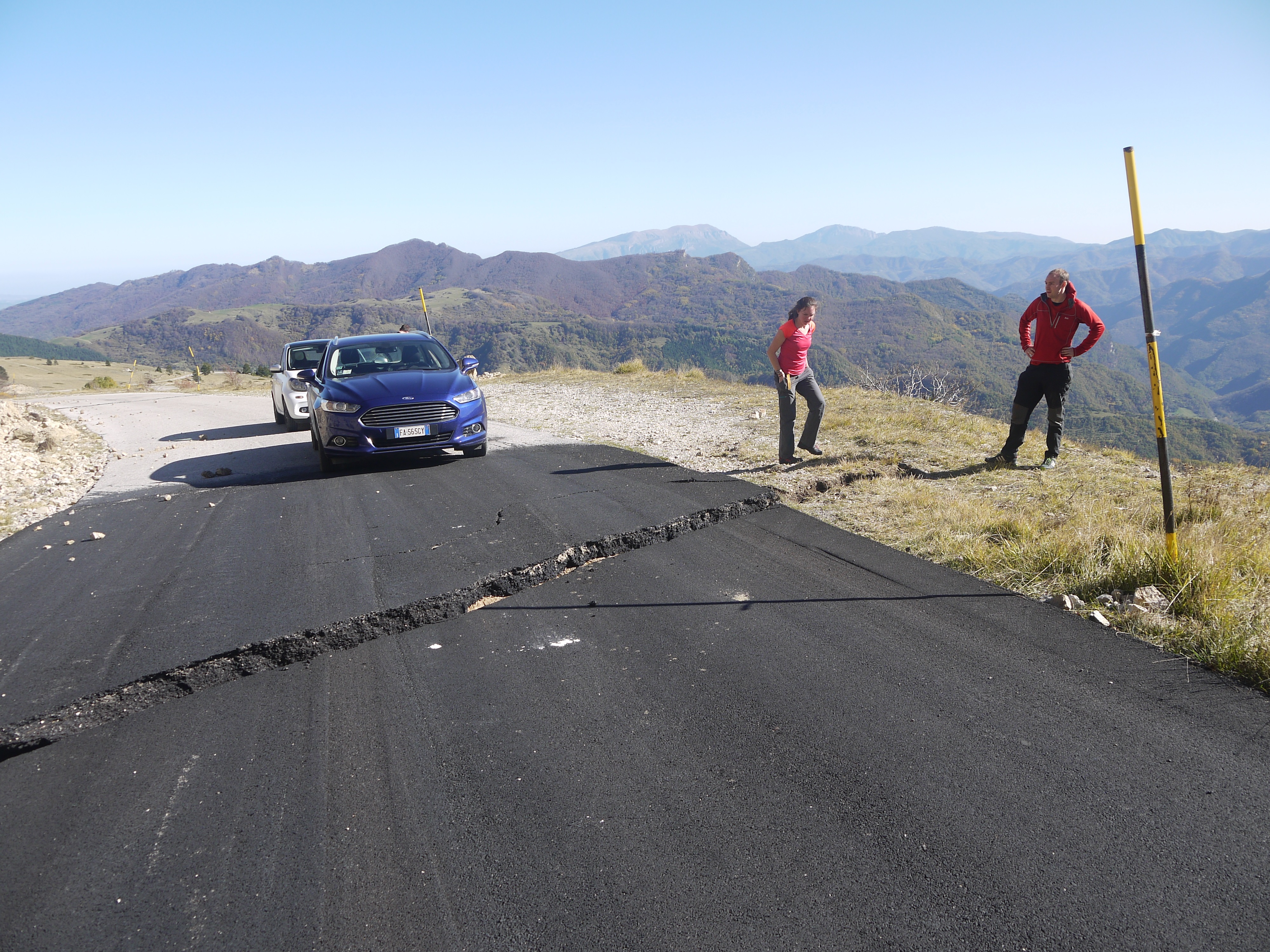
Thousands of aftershocks
Dr Walters and the team used satellite data to estimate which part of the fault failed in each earthquake, and compared this pattern with the location and timing of thousands of tiny aftershocks throughout the seismic sequence.
They found that intersections of small faults with the main fault system separated each of the three largest earthquakes, strongly suggesting these intersections stop the growth of each earthquake and prevent the faults failing in a single large event.
In addition, the scientists also found that after the first earthquake, thousands of aftershocks crept northwards along these same fault intersections at a rate of around 100 metres per day, in a manner consistent with naturally occurring water and gas being pumped along the faults by the first earthquake on 24 August, 2016.
The second earthquake, on the 26 October, occurred exactly when these fluids reached its location, therefore controlling the relative timing of failure.
Dr Walters added: “It was a big surprise that these relatively small faults were having such a huge influence over the whole sequence.
“They stop the first earthquake in its tracks, and then they channel the fluids that start the sequence up again months later. No-one’s ever seen this before.”
Seismic hazard
Co-author and COMET associate Dr Laura Gregory from the University of Leeds said it was important to understand whether or not a fault fails in a seismic sequence, and that the team’s results were only made possible by combining a varied array of different datasets.
Dr Gregory said: “A seismic sequence has vastly different implications for seismic hazard compared to a single large earthquake. If the faults in Italy in 2016 had failed together in one big event, the impact on the local population would have been much worse.
“This is the first time we’ve ever had this quality of modern data over one of these earthquake sequences, and bringing together a range of specialists was key for unpicking how the earthquakes related to one another.
“I was scrambling over the mountainside immediately after each earthquake with British and Italian colleagues, measuring the metre-high cliffs that had suddenly formed. Meanwhile, other members of our team were analysing data from seismometers stationed around the world, or were mapping the tiny bending of the ground around the faults using satellites orbiting the planet at 500 miles altitude.”
The research was partly supported by both COMET and a NERC Urgency Grant.
Satellite data has shed new light on seismic hazard in one of the world’s most deadly earthquake zones.
Published today in Nature Communications, the COMET study describes how tectonic strain builds up along Turkey’s North Anatolian Fault at a remarkably steady rate.
This means that present-day measurements can not only reflect past and future strain accumulation, but also provide vital information on events still to come.
The strain, which builds up as Turkey is squeezed between three major tectonic plates, has caused almost the entire length of the fault to rupture since 1939 in a series of major earthquakes gradually migrating east-west towards Istanbul.
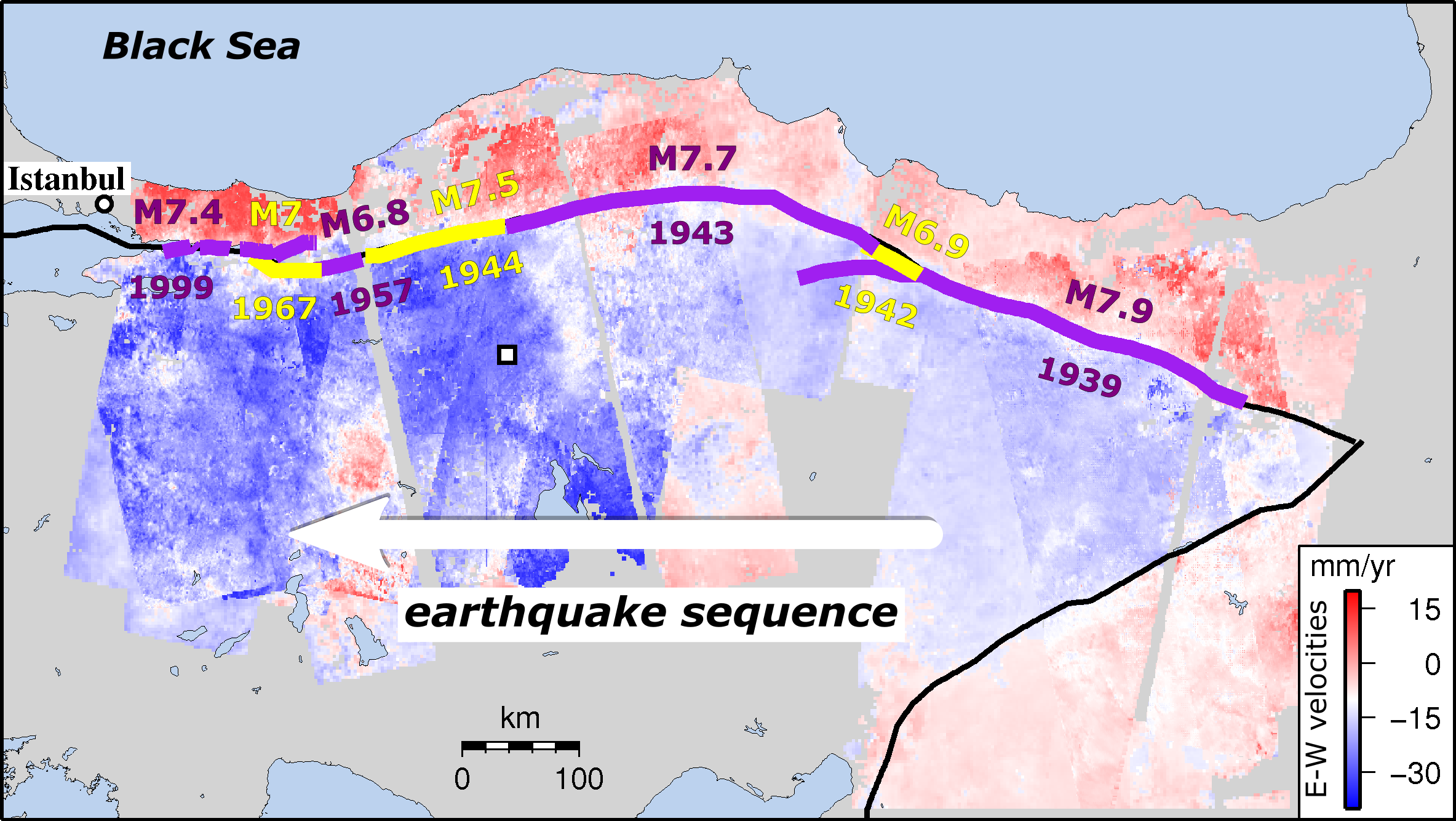
Led by COMET PhD student Ekbal Hussain[1], the team used satellite images from the European Space Agency’s Envisat mission to identify tiny ground movements at earthquake locations along the fault.
Dr Hussain explained: “Because we know so much about the fault’s recent history, we could look at the strain build up at specific places knowing how much time had passed since the last earthquake.”
The 600-plus satellite images, taken between 2002 and 2010, provided insights into the equivalent of 250 years of the fault’s earthquake repeat cycle.
Remarkably, apart from the ten years immediately after an earthquake, strain rates levelled out at about 0.5 microstrain per year, equivalent to 50mm over a 100km region, regardless of where or when the last earthquake took place.
Dr Hussain added: “This means that the strain rates we measure over the short term can also reflect what’s happening in the longer term, telling us how much energy is being stored on the fault and could eventually be released in an earthquake.”
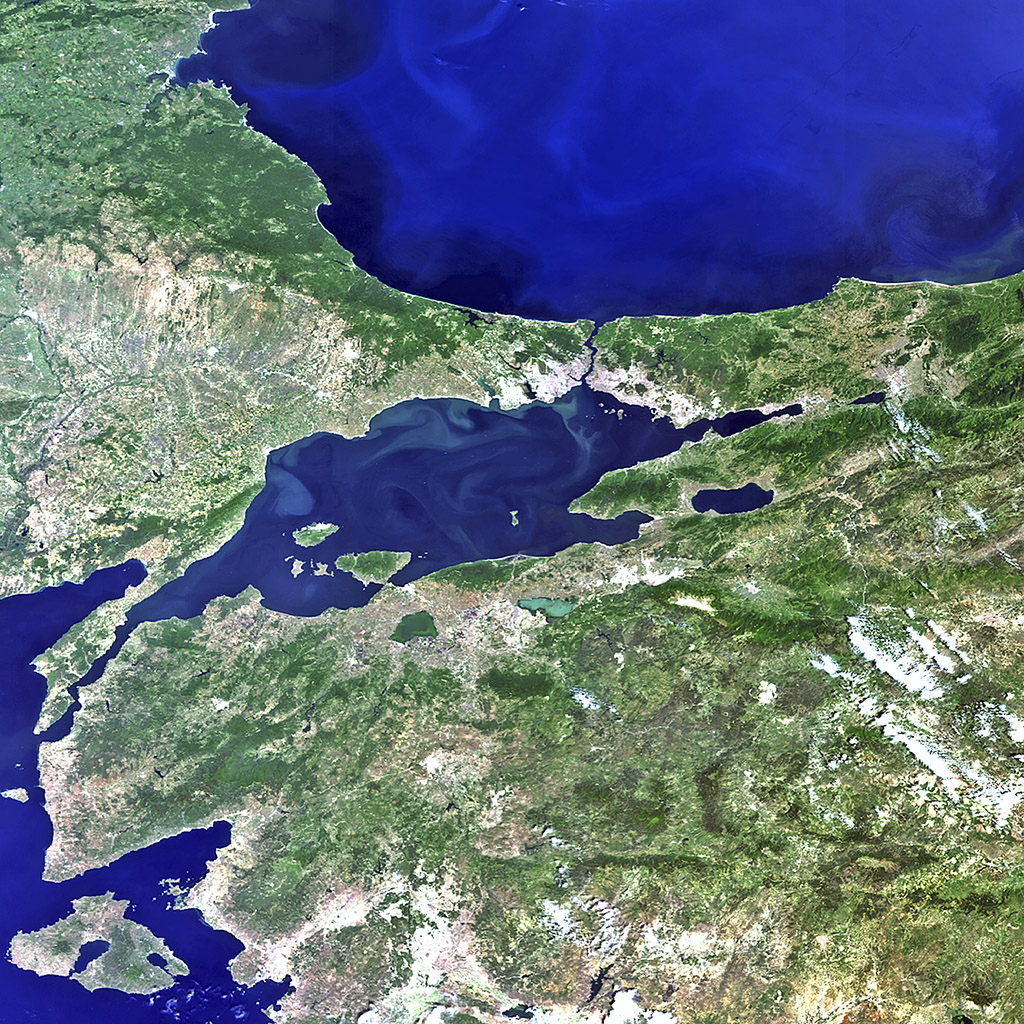
Until the satellite era, it was difficult to get a clear picture of how strain built up on the fault. Now, satellites like Envisat, alongside the newer Sentinel-1 mission, can detect ground movements of less than a millimetre, indicating how and where strain is accumulating.
The findings suggest that some existing hazard assessment models, which presume that strain rates vary over time, need to be rethought. This is especially true for regions where there are long gaps between earthquakes, such as the Himalayas.
Co-author and COMET Director Tim Wright said: “Discovering this consistent strain accumulation will help us to reassess how we model seismic hazards, as well as improving understanding of the earthquake cycle worldwide.”
The full paper is: Hussain et al. (2018) Constant strain accumulation rate between major earthquakes on the North Anatolian Fault, Nature Communications, doi:10.1038/s41467-018-03739-2
[1] Now Remote Sensing Scientist at BGS Keyworth. Dr Hussain is available for comment (ekhuss@bgs.ac.uk).
At about 5:38am local time on 24 June 2017 (21:38 on 23 June 2017 UTC), a massive landslide struck Xinmo Village, Maoxian County, Sichuan Province in China. Sichuan province is prone to earthquakes, including the 2008 Mw 7.9 Wenchuan earthquake that killed over 70,000 people, as well as the 1933 Mw 7.3 Diexi earthquake with a death toll of up to 9300.
Authorities have confirmed that the Maoxian landslide was triggered by heavy rain. The Maoxian landslide swept 64 homes in Xinmo village, blocking a 2km section of river and burying 1,600 meters of road. The collapsed rubble was estimated to be about eight million cubic meters (Figure 1a). Three days later (on 27 June 2017), a second landslide hit Xinmo Village; almost in the same time, another landslide occurred in Shidaguan Town, 20km away from Xinmo Village (Figure 1b).
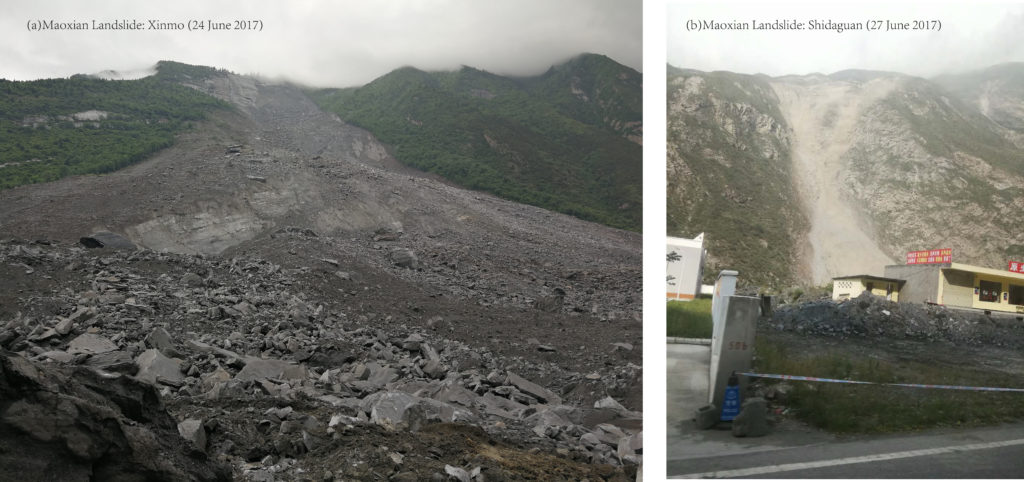
As part of the ESA’s Copernicus Program, the Sentinel-1 mission comprises a constellation of two polar-orbiting satellites, operating day and night performing C-band synthetic aperture radar imaging in all-weather conditions. Sentinel-1 images acquired before and after events such as landslides, earthquakes or volcanoes offer information on the extent and surface displacements of affected areas, which can be used for damage and future hazard assessment.
A joint team from Newcastle University (UK), Chengdu University of Technology, Tongji University, China Academy of Space Technology and Wuhan University (China) have been racing against time to respond these two events by combining ESA’s Sentinel-1, Chinese Gaofen-2/3 with field observations.
“Sentinel-1 acquired a post-event image thirteen and half hours after the Xinmo event, and provided us the first interferogram for the Xinmo landslide.” said Professor Zhenhong Li, Professor of Imaging Geodesy at Newcastle University, “This first Sentinel-1 interferogram, together with its corresponding coherence and amplitude maps, not only helped us identify the source area of this massive landslide, but also assisted with mapping the landslide boundary (Figure 2).”

“More importantly, through the analysis of the archived Sentinel-1 data, we found that pre-event movements exhibited in the source area during the period from 14 May to 19 June 2017 for the Xinmo event.”
Pre-event signals are even clearer for the Shidaguan landslide, suggesting it had been sliding for a while.
“It is well known that landslides are hard to predict” said Professor Qiang Xu, Geologist with Chengdu University of Technology, “This study convincingly demonstrates that InSAR can be used to detect and map active landslides, which is a great achievement.”
After presenting the joint research findings in the Dragon-4 symposium at Copenhagen on 27 June 2017, Professor Deren Li, Academician of Chinese Academy of Sciences (CAS) and Chinese Academy of Engineering (CAE) at Wuhan University concluded, “This joint effort suggests that landslide Early Warning System (EWS) might be encouraging. There are a range of factors we should consider for EWS, such as real time, automatic, spatial and temporal resolutions, and data uncertainty.”
Dramatic data from last year’s major earthquake in Kaikoura, New Zealand, will change the way scientists think about earthquake hazards in tectonic plate boundary zones.
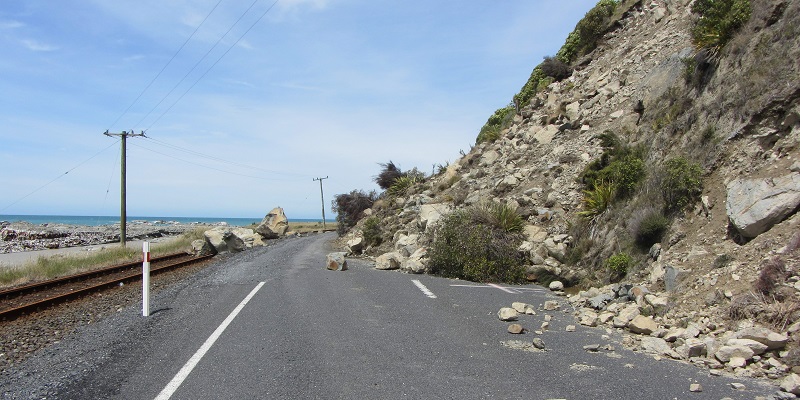
The South Island earthquake was one of the most comprehensively recorded earthquakes in history. Satellite images of the earthquake and its aftermath have enabled scientists to analyse the quake in an unprecedented level of detail.
COMET Director Tim Wright, study co-author, said: “We’ve never seen anything like the Kaikoura quake before, it was one of the most complex ever recorded.
“An earthquake commonly ruptures across a single fault line or faults that are closely grouped; Kaikoura ruptured at least 12 major faults. This challenges many assumptions about how individual faults control earthquake ruptures.”
Immediately following the start of Kaikoura’s earthquake in November, the Sentinel-1 and ALOS-2 satellites were tasked with gathering images and data. COMET researchers at the University of Leeds used the data to provide a rapid analysis of what was happening during the quake.
They found that seismic readings of the earthquake were not giving accurate assessments of where the ruptures were occurring.
Professor Wright said: “Seismic readings are currently the fastest method of gathering earthquake data as they can quickly read shockwaves sent through the earth – but they paint a crude picture. The complexity of the Kaikoura earthquake caused seismologists to completely misinterpret the earthquake based on these seismic waves.
“Satellites such as the European Space Agency’s Sentinel-1 measure the way the ground deforms at very high resolution. The detail in the images showed us that ruptures took place across many separate faults.
“One of the aims of COMET is to expand satellite capability to provide rapid response earthquake data to ensure residents and rescue workers have access to fast and accurate information.”
The satellites provided pre- and post-earthquake images to measure the extent of land movement. Kaikaoura’s earthquake caused sections of earth to move up to 25 metres and created surface ruptures measuring 12 metres. This caused large scale landslides and triggered a tsunami.
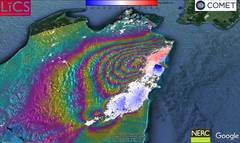
In a study published today in Science, the team of researchers reports the full range of data analysed from Kaikaoura’s earthquake, including satellite imagery, field observation, GPS data and coastal uplift data.
The research will prompt reassessment of how many different faults can be involved in a single earthquake and could potentially feed into revaluations of seismic hazard models.
Lead researcher Dr Ian Hamling, a natural hazards geodesist from New Zealand research institute GNS Science, said: “There was growing evidence internationally that conventional seismic hazard models are too simple and restrictive.
“The message from Kaikoura is that earthquake science should be more open to a wider range of possibilities when rupture models are being developed. It underlines the importance of re-evaluating how rupture scenarios are defined for seismic hazard models.”
New Zealand’s complex network of faults are similar to those found in western United States, Japan and central Asia.
Leeds co-author and COMET Associate Dr John Elliott said: “While earthquakes like Kaikoura’s do not commonly occur, the data we’ve gathered from this event will expand our understanding of similar boundary zones around the world.
“Not only could the data help inform us for the future but it may change how we’ve interpreted ancient earthquakes. If an earthquake like Kaikoura’s took place thousands of years ago, current methods of paleo-seismology would possibly see it as a series of earthquakes over a long period of time, rather than as one large single quake.”
The full paper, ‘Complex multi-fault rupture during the 2016 M7.8 Kaikoura earthquake, New Zealand’ was published on 23 March in Science First Release.
An international team of scientists, led by COMET’s John Elliott, has shed new light on the earthquake that devastated Nepal in April 2015, killing more than 8,000 people.
In a study published in the journal Nature Geoscience, the scientists show that a kink in the regional fault line below Nepal explains why the highest mountains in the Himalayas are seen to grow between earthquakes.
Dr Elliott explained: “We have shown that the fault beneath Nepal has a kink in it, creating a ramp 20km underground. Material is continually being pushed up this ramp, which explains why the mountains were seen to be growing in the decades before the earthquake. The earthquake itself then reversed this, dropping the mountains back down again when the pressure was released as the crust suddenly snapped in April 2015.
“Using the latest satellite technology, we have been able to precisely measure the land height changes across the entire eastern half of Nepal. The highest peaks dropped by up to 60cm in the first seconds of the earthquake.”
Mount Everest, at more than 50km east of the earthquake zone, was too far away to be affected by the subsidence in this event.
The team, which included academics from the USA and France, also demonstrate that the rupture on the fault stopped 11km below Kathmandu. This leaves an upper portion that remains unbroken and will build up more pressure over time as India continues to collide with Nepal, and indicates that another major earthquake could take place within a shorter timeframe than the centuries that might be expected for the area.
Dr Elliott added: “As this part of the fault is nearer the surface, the future rupture of this upper portion has the potential for a much greater impact on Kathmandu if it were to break in one go in a similar sized event to that of April 2015.
“Work on other earthquakes has suggested that when a rupture stops like this, it can be years or decades before it resumes, rather than the centuries that might usually be expected.”
Study co-author Dr Pablo González, from the School of Earth and Environment at the University of Leeds and also a COMET member, said: “We successfully mapped the earthquake motion using satellite technology on a very difficult mountainous terrain. We developed newly processing algorithms to obtain clearer displacement maps, which revealed the most likely fault geometry at depth to make sense of the puzzling geological observations.”
The research paper, Himalayan megathrust geometry and relation to topography revealed by the Gorkha earthquake, was published online in Nature Geoscience on 11 January 2016.
COMET researchers have unravelled a complex seismic sequence using a combination of techniques, explaining not only the earthquake sequence itself but also the formation of the mountain range where it occurred.
On August 18 2014, an Mw 6.2 earthquake struck Murmuri, near Dehloran in the Zagros Mountains of South West Iran (Figure 1), and was followed by five aftershocks of Mw of at least 5.4. The largest of these was a Mw 6.0 aftershock which took place 16 hours after the main event.
These were the first large seismic events in the region since important developments in satellite Earth Observation (EO) have allowed us to study earthquakes in unprecedented detail, providing the potential to combine a range of satellite-based and seismological approaches.
The study team, which included COMET scientists from Cambridge and Oxford along with colleagues from Iran, Colorado, and Canada, saw this as an opportunity to shed light not only on the Murmuri earthquake but also on how the Zagros Mountains themselves are evolving.
Figure 1 below shows the distribution of earthquakes in the region along with the 2014 Murmuri event.

The depth of the earthquake-generating thrust faults in the Zagros Mountains has been the subject of debate for some time. Previous studies have disagreed on whether the faults break a thick sequence of sedimentary layers, or are confined to the underlying crystalline rocks.
Importantly, rather than using a single technique, the team combined satellite-based EO techniques with studies of the seismic waves generated by the earthquake and aftershocks. The first step was to identify their locations, which was crucial to understanding the relationship between the ground motions detected by InSAR and the fault planes that caused the earthquakes. They then used the results to generate models of the faults.
Modelling the seismic waves showed that all except one of the events were caused by thrust faults. The smooth signals in the InSAR interferograms meanwhile showed that the faulting which led to the earthquake was buried deep under the surface.

The next question was whether the earthquakes had been caused by a single or multiple faults. The interferograms showed distinct lobes extending to the east and southeast of the main affected area, suggesting that the displacements on the surface were caused by two if not three separate faults.
COMET’s Alex Copley, from the Department of Earth Sciences at the University of Cambridge, explained: “ We found that a single-fault model couldn’t reproduce the deformation patterns shown by the interferograms, so we investigated by applying multiple-fault models instead.”
The team modelled the faults to establish characteristics including their direction, length and angle. When they used the interferograms alone there were a wide range of different fault parameters that could produce models that matched the data, but by including the seismic data the team could narrow down these characteristics.
Dr Copley added: “The only way we managed to work out what actually happened was by using seismological techniques, and then using these results to interpret the satellite measurements.”
The results showed that the 18 August 2014 event involved significant slip on two planes, which produced a complex displacement pattern in the InSAR, and that there were two separate events big enough to produce surface deformation signals, hence the two lobes on the interferograms.
It also became clear that most if not all of the faulting took place in the sedimentary layers rather than the igneous rocks below, at depths of 3-9km. The faults were also found to be longer than they were deep, which is relatively unusual – most faults tend to be more or less equal in length and depth. This could be because changes in the mechanical properties of the rocks below stop the faults from extending any deeper.
As well as explaining the events at Murmuri, the results throw light on the large scale tectonics of the Zagros Mountains, showing which combination of tectonic forces and material properties of the rocks can give rise to the shape and deformation pattern of the mountain range.
Dr Copley summarised: “If we had used seismology or satellite measurements alone we would have failed to learn much that was new about this earthquake sequence. Instead, our approach allowed us to shed light not only on the formation of the Zagros, but also how similar fold-thrust belts form across the globe.”
The full paper is: Copley, A., Karasozen, E., Oveisi, B., Elliott, J.R., Samsonov, S., Nissen, E. Seismogenic faulting of the sedimentary sequence and laterally-variable material properties in the Zagros Mountains (Iran) revealed by the August 2014 Murmuri (E. Dehloran) earthquake sequence, Geophysical Journal International, 2015 doi: 10.1093/gji/ggv365
Post by Richard Walters, Research Fellow at the University of Leeds with COMET and the Earthquakes without Frontiers project (r.j.walters@leeds.ac.uk)
Active faults and the devastating earthquakes they can trigger do not respect political borders. Whilst the recent earthquakes in Nepal did most damage to the mountain kingdom itself, hundreds of people were also killed or injured in neighbouring China, India and Bangladesh.
The region’s history tells a similar story – the three countries’ earthquake records over the last 500 years are intertwined by shared proximity to the Himalayan mountain belt and its underlying megathrust fault.
Ways of improving resilience to earthquake hazard also need to transcend political boundaries, bringing together scientists and policymakers from the affected countries to share knowledge, experience and ideas.
This principle has led to the Earthquakes without Frontiers (EwF) partnership – a diverse group of natural and social scientists from around the UK. Led by James Jackson of both COMET and the University of Cambridge, EwF is a 5-year initiative funded by NERC and ESRC (the Natural Environment and Economic and Social Research Councils) under the Improving Resilience to Natural Hazards programme.
As well as COMET, the partnership includes researchers from Cambridge, Durham, Hull, Leeds, Northumbria and Oxford Universities, the British Geological Survey, the Overseas Development Institute and Durham’s Institute of Hazard, Risk and Resilience.
The project focuses on three broad regions – China, the Himalayan mountain front (Nepal and Northern India) and Central Asia (Kazakhstan and Kyrgyzstan) – with the key objective of furthering knowledge on earthquakes and landslides in the continental interiors.
Much of this involves using remotely sensed data which complements the project’s cross-border approach. EwF scientists use digital topography and multispectral and optical imagery to research landslide hazard and map active faults, alongside satellite radar to measure the warping of the Earth’s crust and steady interseismic motions as faults build up stress before the next seismic event.
All of this contributes to a wider programme of social and natural scientific research with scientists in the partner countries, as well as being used to run workshops and training events for young international scientists.
Crucially, this knowledge exchange extends to countries dealing with similar hazards – the same types of fault that threaten vast regions in China also cause earthquakes in Italy, and lessons learnt about Iranian faults can inform work on hazard in Kazakhstan and vice versa. As such, EwF brings together scientists from many countries to share knowledge and experience across an even wider network, culminating in the annual EwF partnership meetings, the most recent of which was held in Kathmandu in April 2015.
When a huge Mw7.8 earthquake struck Nepal on the 25th April, it came as a double blow to all within EwF. Nepal is not only one of our focus areas, but many of the UK team also had been in Kathmandu just one week before the earthquake, working and living alongside Nepali colleagues and friends.
The International Charter for Space and Major Disasters was invoked just 3 hours after the earthquake, and over the following few days, space agencies hurriedly tasked their satellites to acquire new imagery over Nepal. We all felt strongly that we should put our combined experience to good use in the immediate aftermath of the Nepal earthquake, and dashed to obtain satellite imagery of the area. In the weeks since we have been working to analyse this imagery in order to aid both disaster relief efforts and hazard re-evaluation.

EwF researchers, along with colleagues at the University of Leeds, used data from the European Space Agency’s Sentinel-1A satellite to measure how the ground was permanently warped by the earthquake. This was greatly assisted by COMET’s new automated processing facility, designed to cope with the vast amount of data from the Sentinel-1 satellites, which helped to produce some of the first radar interferograms of the Nepal earthquake. These mapped how the ground was warped along a 170 km stretch of the fault, moving by up to ~1.4 m near Kathmandu.
We are now modelling the data to understand how the fault slipped at depth, establish the relationship with the large Mw 7.3 aftershock on the 12th May, and gauge how these events may have stressed the surrounding regions, making them more likely to fail in future.
At the same time, EwF scientists at Durham University and the British Geological Survey have been using high-resolution optical and multispectral imagery to map landslides in the region. We have identified around 3,600 landslides that were either triggered or reactivated by the earthquake, using the maps to show where rivers are likely to be dammed and roads blocked. This has also highlighted the need to plan for the monsoon season which may reactivate or trigger even more deadly landslides.

Over the coming months, EwF researchers will continue to work on these topics as well as the many more questions raised by the Nepal earthquake. We hope that the lessons learned from this terrible event will bring us one step closer to improving resilience to future earthquakes, not just for Nepal and the countries across its borders, but for all earthquake-prone countries.
This is an abridged version of an article that appears in the current newsletter of the Geological Remote Sensing Group.